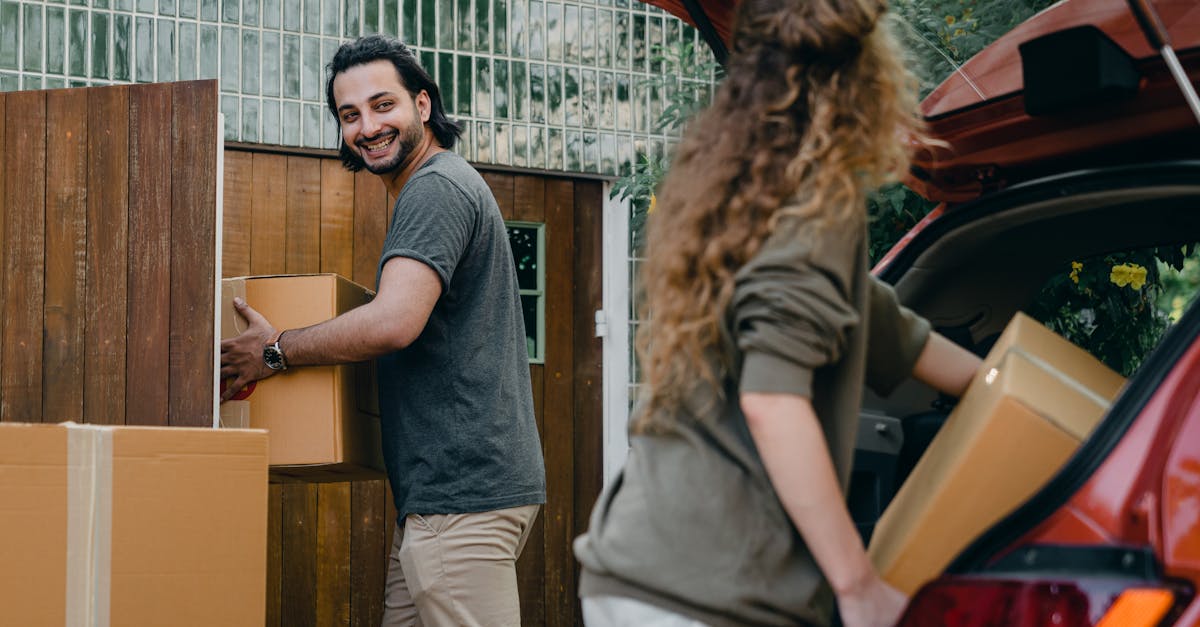Are you considering a move to another state? The thought of starting fresh in a new place can be both exhilarating and overwhelming. From finding a new home to packing up your belongings, there are numerous details that need to be addressed. However, with proper organization and preparation, your interstate move can be a smooth and seamless experience.
In this article, we will provide you with a comprehensive checklist to help you stay organized and prepared during your transition. We understand the challenges that come with moving to another state, and our goal is to alleviate some of the stress by offering practical advice and valuable insights. Whether you are relocating for work, family reasons, or simply seeking new opportunities, our checklist will guide you through each step of the process.
 The Excitement of Moving to Another State
The Excitement of Moving to Another State
Embarking on a journey to a new state is an exhilarating experience brimming with endless possibilities. It offers a chance for personal growth, adventure, and the opportunity to embrace change. The excitement that accompanies moving to another state stems from the allure of exploring unfamiliar landscapes, immersing oneself in different cultures, and building a fresh chapter in life’s narrative.
Leaving behind the familiar can be both daunting and invigorating. The prospect of discovering new neighborhoods, making friends from diverse backgrounds, and indulging in regional delicacies ignites a spark of curiosity within us. Each state has its own unique charm; whether you’re drawn to the vibrant energy of city life or yearning for the tranquility of rural landscapes, there’s something captivating awaiting you.
Moreover, moving to another state allows for a fresh start. It provides an opportunity to redefine oneself, untethered by preconceived notions or expectations. Embracing change can be liberating – it encourages personal growth and opens doors to new experiences that may have previously remained unexplored. By venturing into unfamiliar territory, we challenge ourselves to adapt and thrive in new environments.
 How to Stay Organized and Prepared: A Checklist for Your Interstate Move
How to Stay Organized and Prepared: A Checklist for Your Interstate Move
When it comes to moving to another state, organization and preparation are key. Ensuring a smooth transition requires careful planning and attention to detail. To help you stay organized and prepared, we have compiled a comprehensive checklist that covers all the essential aspects of your interstate move.
Research Your New State: Understanding the Basics
Before embarking on your move, it is crucial to familiarize yourself with your new state. Start by researching the cost of living, climate, local laws and regulations, healthcare facilities, schools, and other key factors that pertain to your lifestyle. This knowledge will enable you to make informed decisions throughout the moving process.
Additionally, take the time to explore different neighborhoods or cities within your destination state. Consider factors such as proximity to amenities, commute times, crime rates, and overall quality of life. By conducting thorough research beforehand, you can narrow down your options and choose the perfect location for your new home.
Establishing a Moving Budget: How to Plan and Save for Your Move
Moving costs can quickly add up if not properly budgeted. As you plan your interstate move, create a detailed budget outlining all potential expenses such as packing supplies, professional movers (if desired), transportation fees, temporary accommodation costs (if applicable), utility connections or transfers, and any unforeseen expenses.
To save money during your move, consider decluttering your belongings before packing. Sell or donate items you no longer need or use; this not only reduces moving costs but also allows for a fresh start in your new home. Additionally, compare quotes from different moving companies or truck rental services as prices can vary substantially.
 Finding and Securing a New Home in Your Destination State
Finding and Securing a New Home in Your Destination State
With your budget established, begin your search for a new home in your destination state. Utilize online resources, such as real estate websites and rental platforms, to browse available properties. Consider your must-haves and preferences regarding the type of dwelling, size, location, amenities, and lease or purchase terms.
Once you have identified potential homes, schedule visits or virtual tours to assess their suitability. Take note of any repair or maintenance needs and factor this into your decision-making process. When you have found the perfect place, be prompt in securing it by completing all necessary paperwork and fulfilling any financial obligations required by the landlord or real estate agent.
By following these guidelines and incorporating our checklist into your moving plan, you can ensure an organized and prepared interstate move. Remember to approach each step with patience and positivity; embracing change opens doors to new opportunities and experiences that await you in your new state.
Research Your New State: Understanding the Basics
Embarking on a new adventure in a different state is undoubtedly thrilling, but to ensure a smooth transition, it is essential to research and understand the basics of your destination state. Familiarizing yourself with key information will not only help you adapt seamlessly but also enable you to make informed decisions throughout the moving process.
Begin by researching the demographics, climate, and geography of your new state. Understanding these aspects will give you valuable insights into what to expect upon arrival. Additionally, delve into the cost of living index, as it will guide you in budgeting for expenses such as housing, transportation, groceries, and healthcare.
Moreover, explore the job market and employment opportunities in your destination state. This knowledge will aid you in preparing for your professional life there. Investigate industries that thrive in your new location and identify potential employers or networking opportunities within those sectors. By doing so, you can lay the groundwork for a successful career transition and embrace exciting possibilities.
 Establishing a Moving Budget: How to Plan and Save for Your Move
Establishing a Moving Budget: How to Plan and Save for Your Move
When planning a move to another state, one of the most crucial aspects to consider is establishing a moving budget. Careful planning and saving can help alleviate the financial stress that often accompanies such a significant transition. By following these steps, you can ensure that you are well-prepared for the costs involved and maintain peace of mind throughout the process.
Firstly, assess your current financial situation by calculating your income, expenses, and savings. Be thorough in identifying any potential surplus or deficit to determine how much you can allocate towards your move. Consider creating a separate savings account dedicated solely to your relocation expenses. This way, you can track your progress and keep your moving funds separate from other expenditures.
Next, research the average cost of living in your new state. Take into account factors such as housing prices, transportation costs, taxes, utilities, and healthcare expenses. This information will enable you to make informed decisions when budgeting for each category. It’s important to be realistic about these costs so that you won’t face any unpleasant surprises after moving.
Finding and Securing a New Home in Your Destination State
Embarking on a journey to a new state is an exhilarating experience, but the process of finding and securing a new home can sometimes feel overwhelming. However, with careful planning and research, you can navigate this stage smoothly. Start by exploring various neighborhoods and cities within your destination state to determine which area aligns with your preferences and lifestyle. Consider factors such as proximity to schools, amenities, transportation options, and the overall vibe of the community.
Once you have identified your preferred location, it’s time to dive into the housing market. Begin by researching real estate listings online or seek assistance from local real estate agents who possess in-depth knowledge of the area. Make a list of potential properties that meet your requirements for size, budget, and any specific features you desire.
Gaining firsthand insight into your prospective neighborhoods is crucial before making any final decisions. If possible, plan a trip to visit your destination state in advance or take advantage of virtual tours provided by many real estate agencies nowadays. This will allow you to get a feel for the community and assess whether it resonates with your aspirations.
Packing and Organizing: Tips for a Smooth Transition
When it comes to moving to another state, packing and organizing your belongings can be quite a daunting task. However, with the right strategies in place, you can make this process more efficient and less overwhelming. Here are some valuable tips that will help ensure a smooth transition:
Create an Inventory: Before you start packing, take some time to create an inventory of all your belongings. This will not only help you keep track of what you have but also assist in determining what items are essential and what can be left behind. Consider categorizing your inventory by room or by type of item to make unpacking at your new home easier.
Declutter Your Possessions: Moving to another state provides an excellent opportunity to declutter your life. Take the time to go through each item and decide if it’s worth bringing along or if it’s time to part ways. Donate or sell items that no longer serve a purpose in your life, reducing both the physical and emotional baggage you carry with you.
Create a Packing Plan: Proper planning is key when it comes to packing effectively for an interstate move. Start by gathering all necessary supplies such as sturdy boxes, packing tape, bubble wrap, and markers for labeling boxes. Begin with non-essential items first and gradually work your way towards everyday essentials. Label each box with its content and the room it belongs in so that unpacking becomes effortless later on.
Moving can sometimes feel overwhelming, but approaching the task of packing and organizing systematically can alleviate stress significantly. By creating an inventory of your possessions, decluttering where necessary, and devising a well-thought-out packing plan, you’ll be well on your way to achieving a smooth transition into your new home state.
Hiring Professional Movers: Simplifying Your Interstate Move
When it comes to moving to another state, the task of packing up your entire life and transporting it across long distances can be overwhelming. This is where hiring professional movers can make a significant difference. Not only do they alleviate the physical strain of lifting heavy furniture and boxes, but they also bring with them years of experience and expertise in handling interstate moves.
One of the first steps in hiring professional movers is conducting thorough research. Take the time to compare different moving companies, read customer reviews, and gather multiple quotes. Look for reputable movers that are licensed and insured, as this ensures a certain level of professionalism and accountability.
Once you have narrowed down your options, schedule in-home estimates with at least three moving companies. During these estimates, representatives from each company will assess the size of your move, discuss any special requirements you may have, and provide you with a detailed cost breakdown. This will allow you to make an informed decision based on both price and quality of service.
Transferring Utilities and Address Change Notifications
When moving to another state, it is crucial to ensure a smooth transition when it comes to transferring your utilities and updating your address. This process may seem overwhelming at first, but with proper organization and planning, you can make this task more manageable. By following a few simple steps, you can ensure that your new home is ready for you to settle into.
Start by contacting your current utility providers several weeks in advance of your move. Inform them of your moving date and provide them with the address of your new home. Arrange for the disconnection of services at your current residence on the day after you move out, ensuring that you have utilities available until then.
Next, research utility providers in your new state. Contact them as soon as possible to set up service installation dates that align with your moving schedule. Be sure to inquire about any required documents or identification needed for initiating services.
As for address change notifications, begin by updating important accounts such as banks, insurance companies, and credit card providers with your new address. You may also want to notify government agencies like the Social Security Administration or the Department of Motor Vehicles if applicable.
To redirect mail from your old address to the new one, visit the local post office or use their online services to submit an official change of address request. This ensures that important mail reaches you without delay.
Remember: transferring utilities and updating addresses are vital steps in settling into your new state smoothly. By proactively reaching out to utility providers and making necessary changes well ahead of time, you’ll make sure that all vital services are ready when you arrive at your destination.
Updating Your Important Documents and Licenses
When you are preparing for a move to another state, it is crucial to ensure that all your important documents and licenses are updated accordingly. Taking care of this aspect in advance will save you from unnecessary complications and ensure a smooth transition to your new home. Here are some key documents and licenses you should consider updating:
Firstly, let’s talk about your driver’s license. Contact the Department of Motor Vehicles (DMV) in your new state as soon as possible to find out the requirements for obtaining a new driver’s license. Some states may require you to take written or driving tests, while others may simply allow you to transfer your existing license. Be prepared by gathering the necessary identification documents, such as proof of residency, social security number, and current driver’s license.
Next on the list is your vehicle registration. Each state has its own rules regarding vehicle registration, so make sure to research these regulations beforehand. You may need to obtain new license plates and registration stickers specific to your new state. Check with the local DMV or equivalent agency for instructions on how to transfer your vehicle registration and what documents are required.
Don’t forget about your important personal documents either! This includes updating your mailing address with the United States Postal Service (USPS) so that all crucial correspondence reaches you at your new location. Additionally, notify banks, credit card companies, insurance providers, healthcare providers, and any other institutions where you have accounts or services about your change of address.
Making Arrangements for Your Beloved Pets
One of the most important aspects of moving to another state is ensuring the well-being and happiness of your beloved pets. Moving can be a stressful experience for animals, but with careful planning and preparation, you can make the transition as smooth as possible for them. Here are some essential steps to take when making arrangements for your furry friends:
1. Research Pet-Friendly Accommodations: Before you move, it’s crucial to find pet-friendly accommodations in your new state. Look for rental properties or neighborhoods that are known to be welcoming towards pets. Consider proximity to parks, walking trails, and veterinary clinics as well. Ensure that your new home meets the requirements and regulations for housing pets.
2. Update Identification and Microchips: Before embarking on your interstate move, make sure all your pets have updated identification tags with your new contact information. It’s also advisable to microchip them if they aren’t already microchipped. This provides an added layer of security in case they accidentally get lost during the transition.
3. Prepare a Travel Kit: As you pack up your belongings, don’t forget to assemble a travel kit specifically tailored to your pets’ needs. Include essential items such as food, water bowls, litter boxes (for cats), bedding, toys, medications (if applicable), leashes/harnesses/crates/carriers, and any comforting items that will help them feel safe during transportation.
Moving is undoubtedly a significant change for both you and your furry companions; however, by researching pet-friendly accommodations in advance, updating their identification information diligently, and preparing a comprehensive travel kit tailored specifically to their needs; you can minimize stress and ensure a positive experience throughout the journey.
Connecting with Your New Community: Tips for a Seamless Transition
When you move to a new state, it’s not just about finding a new home or adjusting to a different climate. It’s also about connecting with your new community and building relationships that will make your transition smoother and more enjoyable. Here are some valuable tips to help you establish connections and feel at home in your new surroundings.
Discover Local Events and Groups
One of the best ways to immerse yourself in your new community is by exploring local events and joining groups that align with your interests. Check out community bulletin boards, online event calendars, or even social media platforms to stay updated on happenings in your area. Whether it’s attending farmer’s markets, art festivals, or joining hobby clubs, participating in these activities will introduce you to like-minded individuals who can become potential friends.
To take it a step further, consider volunteering for local organizations or charities. Not only will this allow you to give back to your community, but it will also provide an opportunity for you to meet people who share similar values and passions. Plus, dedicating your time and skills can be incredibly fulfilling and rewarding.
Engage with Local Businesses
Sometimes the best connections can be found right in your neighborhood! Take the time to visit local businesses such as coffee shops, bookstores, or restaurants. Strike up conversations with owners or employees—ask them for recommendations on things to do around town or inquire about any hidden gems they might know of.
By supporting local businesses, not only are you contributing directly to the growth of your new community but also creating opportunities for personal connections. You might find yourself chatting with other patrons at a cafe or striking up conversations while browsing through shelves at a bookstore. These encounters can lead to lasting friendships and a sense of belonging in your new home.
Attend Community Events
Keep an eye out for community events such as block parties, neighborhood barbecues, or town hall meetings. These events are fantastic opportunities to meet your new neighbors and become more involved in local affairs. Participating in such gatherings will not only help you establish connections but also provide a deeper understanding of the community dynamics.
When attending these events, remember to be open-minded and approachable. Smile, introduce yourself to others, and show genuine interest in getting to know them. Engage in conversations about shared experiences or local attractions—this will help break the ice and foster meaningful connections that can make your new state feel like home.
Conclusion
Moving to another state can be an overwhelming task, but with the right checklist and proper organization, it can also be an exciting adventure filled with new opportunities. By thoroughly researching your new state, planning your budget, finding a suitable home, and efficiently packing your belongings, you are setting yourself up for a smooth transition. Hiring professional movers will alleviate some of the stress associated with moving day, and remembering to transfer utilities and update important documents will ensure a seamless adjustment. Finally, as you settle into your new community, embrace the chance to connect with others and create lasting memories in your new surroundings. Embrace this journey with optimism and open-mindedness – after all, moving to another state is an opportunity for growth and fresh beginnings.






